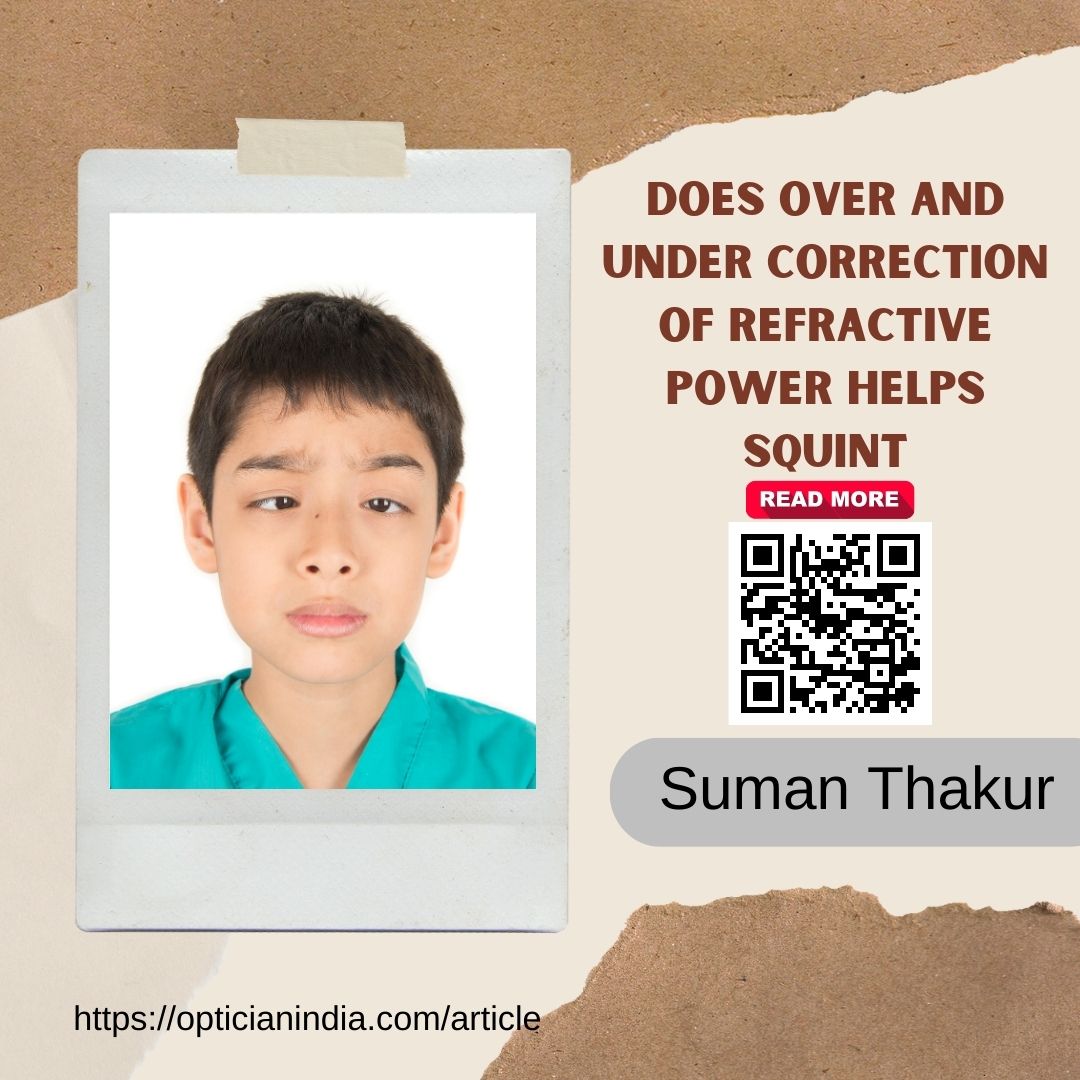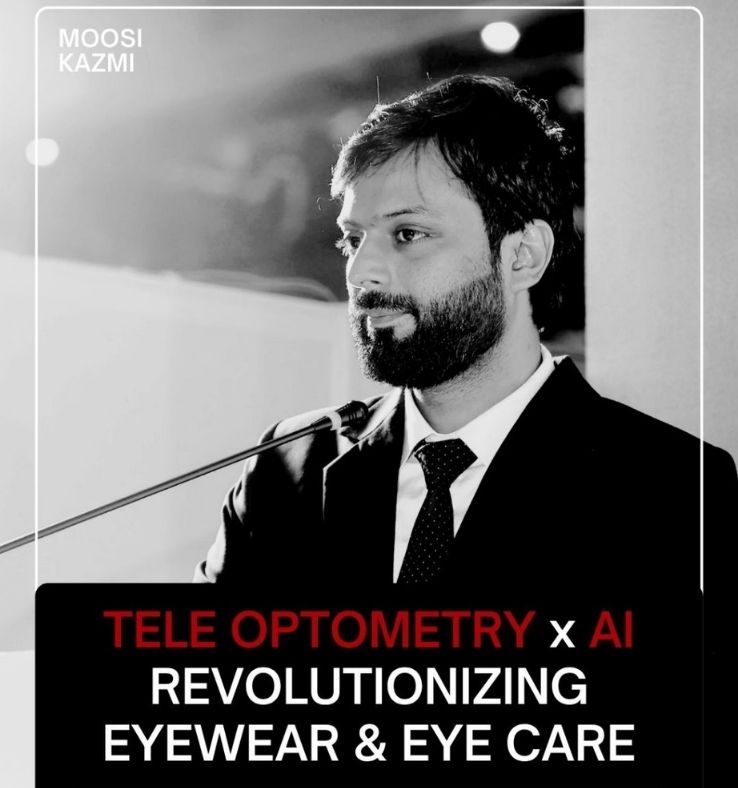DOES OVER AND UNDER CORRECTION OF REFRACTIVE POWER HELPS SQUINT

The misalignment of the visual axis is known as squint. The accommodative and fusional components play a huge role in controlling the squint. If none of these components is able to control squint, leading to manifestation then the refractive power or change in refractive power does not make a huge difference in treating squint and if the squint have already lead to suppression or diplopia in sensory response then the final call for treatment is surgery.Manifesting squint cannot be controlled using fusion.[2]
But some squints can be treated with the help of accommodation and fusional components, these components are present in our own human eye or we can even help in stimulating or relaxing these components by changing the refractive power of glasses.
HOW REFRACTIVE POWER CONTROLS ACCOMMODATION
The positive refractive power helps in relaxing the accommodation in concert relaxing accommodative convergence. Plus lenses are made of both side base in prism so the rays passing through it converges and this is how even the rays going beyond retina is brought to retina with help of plus lens .So on inducing plus power in front of eye we don’t have to accommodate more to bring object on focus simultaneously controlling accommodative convergence .
The negative refractive power helps in stimulating accommodation and concurrently stimulates the accommodative convergence.Accommodation is stimulated with minus lenses [2]. Minus lenses are made of both side base out prisms and the rays passing through it diverges wherefore rays diverging beyond retina stimulates the natural lens to increase its convexity to make the rays fall in retina i.e stimulating accommodation synchronously stimulating accommodative convergence.
 |
HOW ACCOMMODATION CONTROLS SQUINT
Depending upon the types of squint, the accommodative mechanism plays a vital role in controlling it. When we are accommodating our eyes the accommodative convergence is also induced due to which both eyes come closer to each other in a convergence position. When we are relaxing the accommodation our eyes goes in diverging position.
So when the eye is deviating outside stimulation of accommodation helps in keeping both eyes together or inside. And when the eyes are deviating inside the eyes needs relaxation of accommodation to trigger our eyes to diverge.
As mentioned above, the role of refractive power controlling squint. Below have been described how over and under correction of refractive power controls squint.
OVERCORRECTION AND UNDER CORRECTION OF REFRACTIVE POWER
Overcorrecting of refractive power means adding up the number more than patients refractive error and under correction of refractive power means uncorrected refractive error or reducing the amount of refractive error.
Exotropia is the outward deviation of the eye. When our tendency of eye is to deviate outward then we must stimulate our accommodation so that our eyes come closer to each other with the help of accommodation. Therefore when we are treating outward deviation of eyes we can add up or over correct the minus number or if the refractive power is in plus form we can under correct or reduce the plus number pushing into the minus side. So in both the case of refractive error we are increasing the tendency of eyes to stimulate accommodation which increases the accommodative convergence helping the eyes to come closer to each other onwards treating outward deviation. Overcorrecting minus lens therapy has been recommended as a treatment for intermittent exotropia [3,4]. Patient below 8 yrs have very good accommodative power so in the case of outward deviation at this age group can be even prescribed with over minus lenses helping them to stimulate accommodation and treating the deviation
Esotropia means inward deviation of eyes and if the inward deviation of eyes is caused due to high accommodation then for controlling the squint we must relax accommodation. We can relax accommodation by giving the full plus power as we know plus lenses helps in relaxing the accommodation or if the refractive error is in minus form we can even reduce the minus number pushing it into plus form which will help in relaxing the accommodation simultaneously controlling the squint
Accommodative effort is thought to precipitate a convergent misalignment of the eyes as a result of increased hyperopic refractive error (an increased accommodative demand) and/or increased accommodative convergence to accommodation (AC/A) ratio (excessive accommodative convergence). [5,6] . Hence full hyperopic correction is required to decrease the demand of accommodation for correcting hyperopic refractive error simultaneously controlling convergent squint i e esotropia
While over correcting and under correcting the refractive power we must not forget there must not be any change in visual status of the patient the visual acuity must be same or better helping them from not leading into amblyopia.
And if the tendency of deviation is manifest then over and under correction of refractive power will not be an effective way of treatment surgery will be the best option in it.
References
1.Edward L, Raab. Pediatric Ophthalmology and Strabismus. San Francisco: American Academy of Ophthalmology. 2010-2011:89-95
2.. Chen AH, O'Leary DJ. Free-space accommodative response and minus lens-induced accommodative response in pre-school children. Optometry. 2000;71:454a
3.Kennedy J The correction of divergent strabismus with concave lenses. Am J Optom Arch Am Acad Optom. 1954;31605- 614
4.Caltreider NJampolsky A Overcorrecting minus lens therapy for treatment of intermittent exotropia. Ophthalmology.
1983;901160- 1165
5.Parks MM. Abnormal accommodative convergence in squint. AMA Arch Ophthalmol . 1958; 59: 364–380.
6.Raab EL. Etiologic factors in accommodative esodeviation. Trans Am Ophthalmol Soc . 1982; 80: 657–694

.jpg)

.jpg)
.jpg)
.jpg)


1.jpg)



.jpg)
.jpg)



_(Instagram_Post).jpg)
.jpg)
_(1080_x_1080_px).jpg)


with_UP_Cabinet_Minister_Sh_Nand_Gopal_Gupta_at_OpticsFair_demonstrating_Refraction.jpg)
with_UP_Cabinet_Minister_Sh_Nand_Gopal_Gupta_at_OpticsFair_demonstrating_Refraction_(1).jpg)

.jpg)








.jpg)



.png)




